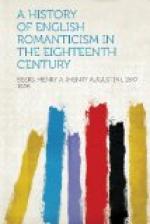[14] “Selections from Newman,” Introduction, pp. xlvii-xlviii.
[15] Racine observes that good sense and reason are the same in all ages. What is the result of this generalization? Heroes can be transported from epoch to epoch, from country to country, without causing surprise. Their Achilles is no more a Greek than is Porus an Indian; Andromache feels and talks like a seventeenth-century princess: Phaedra experiences the remorse of a Christian.—Pellissier, “Literary Movement in France," p. 18.
In substituting men of concrete, individual lives for the ideal figures of tragic art, romanticism was forced to determine their physiognomy by a host of local, casual details. In the name of universal truth the classicists rejected the coloring of time and place; and this is precisely what the romanticists seek under the name of particular reality.—Ibid. p. 220. Similarly Montezuma’s Mexicans in Dryden’s “Indian Emperor” have no more national individuality than the Spanish Moors in his “Conquest of Granada.” The only attempt at local color in “Aurungzebe”—an heroic play founded on the history of a contemporary East Indian potentate who died seven years after the author—is the introduction of the suttee, and one or two mentions of elephants.
[16] See “Les Orientales” (Hugo) and Nerval’s “Les Nuits de Rhamadan” and “La Legende du Calife Hakem.”
[17] The rules a nation, born to serve, obeys;
And Boileau still
in right of Horace sways.
—Pope,
“Essay on Criticism,"
[18] These critical verse essays seem to have been particularly affected by this order of the peerage; for, somewhat later, we have one, “On Unnatural Flights in Poetry,” by the Earl of Lansdowne—“Granville the polite.”
[19] “Epistle to Sacheverel.”
[20] “Essay on Addison.”
[21] Sweet hour of twilight!—in the solitude
Of the pine forest,
and the silent shore
Which bounds Ravenna’s
immemorial wood,
Rooted where once
the Adrian wave flowed o’er,
To where the last Caesarian
fortress stood,
Evergreen forest!
which Boccaccio’s lore
And Dryden’s lay made
haunted ground to me,
How have I loved
the twilight hour and thee!
—Don
Juan
[22] I must entirely agree with Monsieur Boileau, that one verse of Vergil is worth all the clinquant or tinsel of Tasso.—Spectator, No. 5.
[23] Spectator, No. 419.
[24] See his “Life of Collins.”
[25] Spectator, No. 40.
[26] “The Verse”: Preface to “Paradise Lost.”
[27] Dedicatory epistle to “The Rival Ladies.”
[28] Mr. Gosse says that a sonnet by Pope’s friend Walsh is the only one “written in English between Milton’s in 1658, and Warton’s about 1750,” Ward’s “English Poets,” Vol. III, p. 7. The statement would have been more precise if he had said published instead of written.




